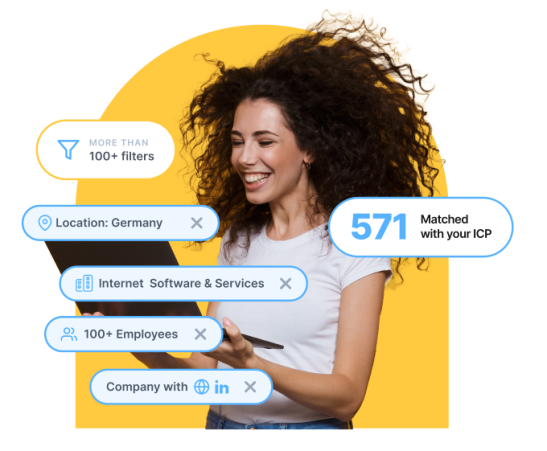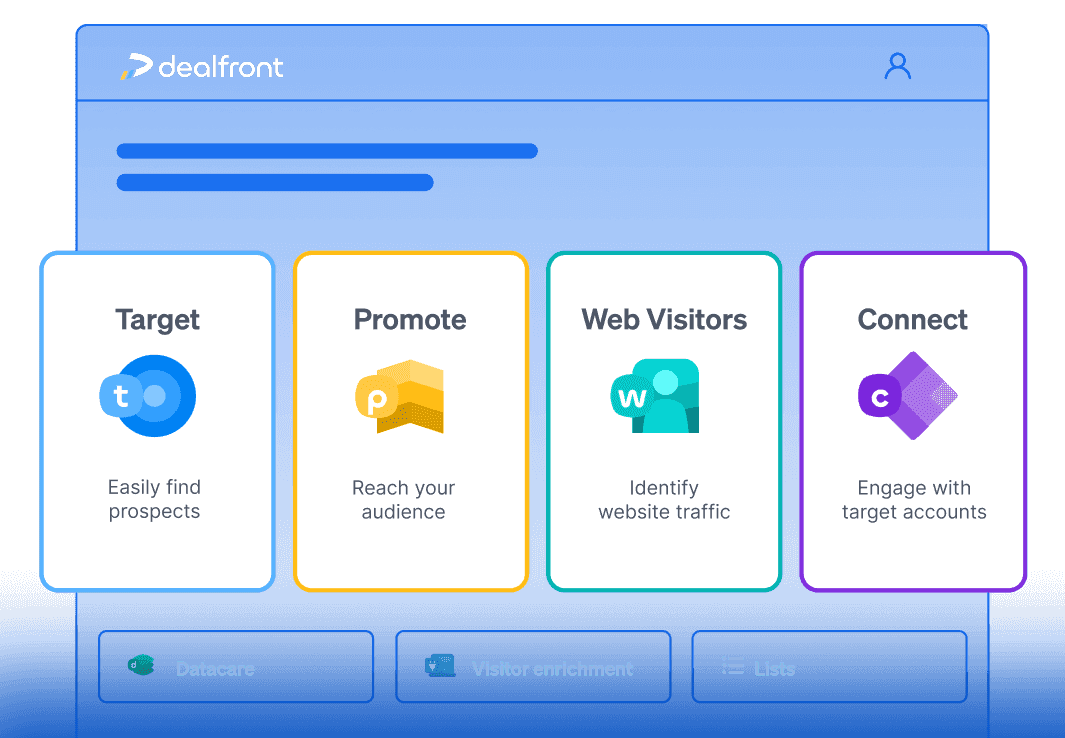If you’re working in B2B sales, you may have heard the term “trigger events” or “sales triggers” before. This article covers all you need to know about trigger events and how to get the most out of this incredibly helpful sales tactic. We’ll show you what trigger events are, what they can do, and how they help drive sales for your B2B business.
What are trigger events?
In B2B sales, a trigger event or sales trigger is an event that gives you an opportunity to make a sale at a company you are targeting.
Let’s say you sell office equipment. Any time one of your target customers opens a new office, that’s a perfect trigger event for you to reach out and make a sales pitch.
The events can come in many different forms. Some may be positive from the customer’s perspective (like opening a new location or expanding to an international market), others can be negative (like downsizing in response to a drop in revenue).
On one hand, B2B sales teams can use trigger events as an opportunity to engage with entirely new individuals or businesses. On the other hand, trigger events also serve as a reminder to more actively nurture and warm up your existing customer relationships. For example, a trigger event can be a moment to congratulate a long-standing customer when their company reaches a milestone, like an anniversary or winning an award. Your customers will appreciate your attentiveness.
The main thing to remember is that trigger events create a logical opportunity for you to get in touch with a new or existing customer about a potential sale.
How trigger events boost your B2B sales strategy
The success of your B2B sales depends on many factors. In addition to having the best sales teams and fostering strong customer relations, it’s also crucial to have a solid sales and marketing strategy and effective lead generation.
No matter how great your strategy is, or how talented your sales and marketing teams are, your product will only sell if customers actually need it.
B2C sales teams have been generating demand for their products for years. Today, B2B sales professionals are also discovering the power of demand generation. After all, their customers are human beings too, and their purchasing decisions are just as easily influenced by strong storytelling and an emotionalized sales experience.
That’s also why the right timing is so important. Whether you’re selling highly specialized products and services, or everyday consumables that any company needs, finding the right moment for your sales pitch is always key.
B2B customers have a wide variety of suppliers to choose from. By identifying the perfect opportunity to make your sales pitch, you gain a powerful competitive advantage. That’s what makes trigger events such an important component of any successful B2B sales strategy.
5 top benefits of trigger events for B2B sales
Here are the top 5 benefits of incorporating trigger events into your B2B sales strategy:
1. A personalized conversation starter
Probably the coolest advantage of sales trigger events is that they provide you with the perfect conversation starter.
Suppose you are working for a recruitment agency. You see that a company in your target group is suddenly posting lots of vacancies online and trying to fill a large number of new positions. It’s the perfect chance for you to reach out and make your case.
By monitoring your companies that fall within your ideal customer profile (ICP) and taking action when you see they are showing a need for your products and services, you can proactively reach out and draw their attention to what you’re selling. And since you already know that they’re looking for a product or service like yours, you’ve got a perfect way to start the conversation. They’ll probably also be impressed that you’ve done your homework.
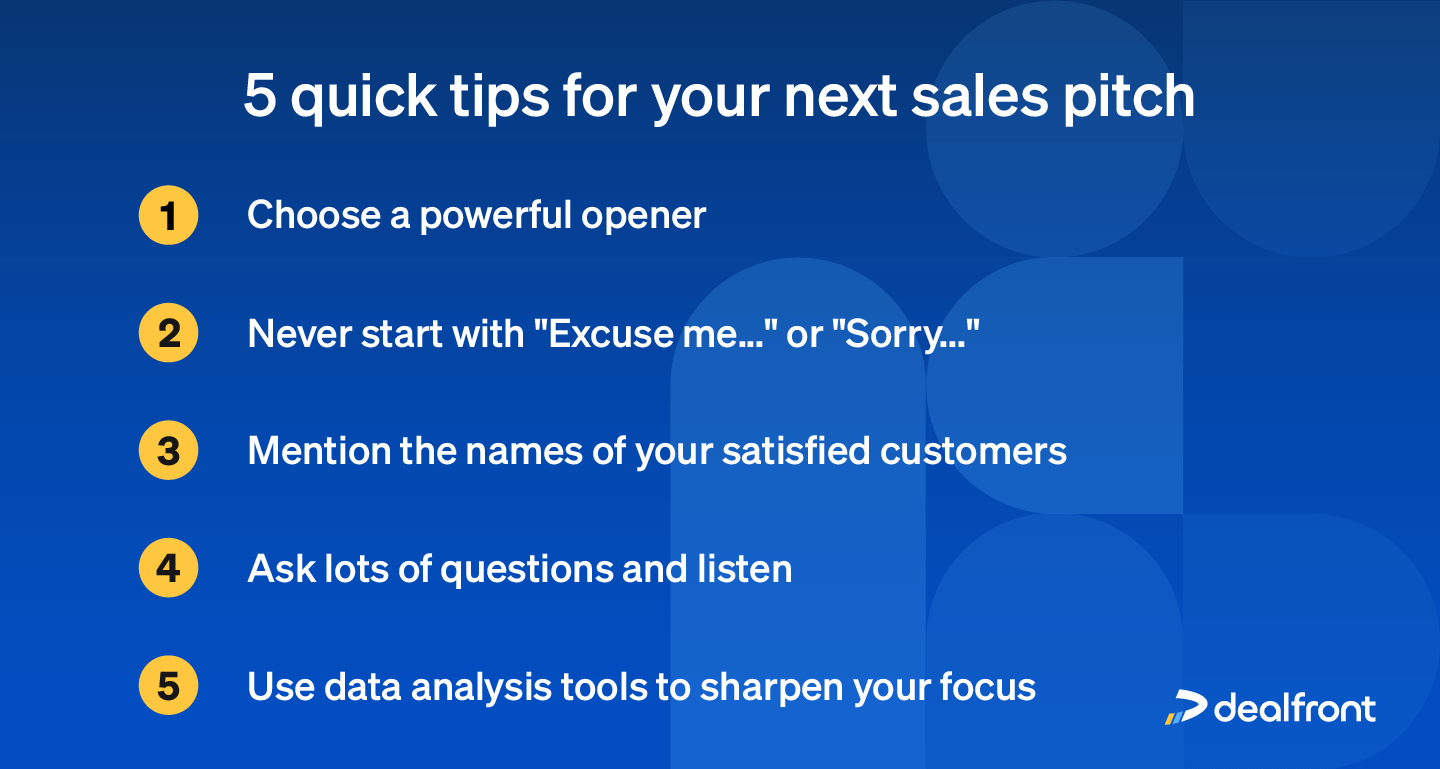
2. Perfect timing
In sales, timing is everything. Let’s stick with the same example: Suppose you make a cold call to a company that matches your ICP, but currently isn’t advertising any job openings (which means they’re probably not hiring at the moment).
At best, you’d probably be wasting your time. At worst, the customer might be annoyed by your call, leaving a bad impression.
Trigger events help you contact potential customers with greater certainty. You know they need your product/service, so you’ve got much less to lose by getting in touch.
If you know for sure that your potential customer is expanding their workforce, then chances are, they’ll be interested in hearing how you can help.
3. Opportunities for cross-selling and upselling
Trigger events can also enhance your cross-selling and upselling to existing customers. Imagine you’re working for a wholesaler and one of your long-time customers, a construction company, is awarded a high-profile new contract. It’s a perfect moment to reach out and congratulate them – but also to ask if they might be needing some extra materials for the big new project.
A trigger event like this is especially effective because it is a “good news” event for the customer. It’s an ideal moment to congratulate them and follow up by talking about how you can help them.
4. Getting ahead of the competition
No matter how great your company’s product or service is, the truth is: being the first company to make a sales pitch gives you a strong competitive advantage. Potential customers are far more likely to remember the first brand that approached them with an offer.
On top of that, many companies don’t have a lot of time or energy to carefully gather and review a large number of competing offers. That means you greatly increase your chances of success if you get in touch immediately whenever you spot a trigger event. That way, you get through to the customer exactly when they need your product or service the most, which saves them the trouble of having to search the target market themselves.
5. Easy to integrate into your existing sales process
It’s usually very easy to integrate trigger events into your sales processes. One option is to use a Sales Intelligence tool like Dealfront which sends you an email to notify you when a trigger event has occurred.
You can also integrate your Sales Intelligence tool directly into your CRM system using Zapier. Then you’ll automatically receive trigger event notifications alongside all your other important sales-related information.
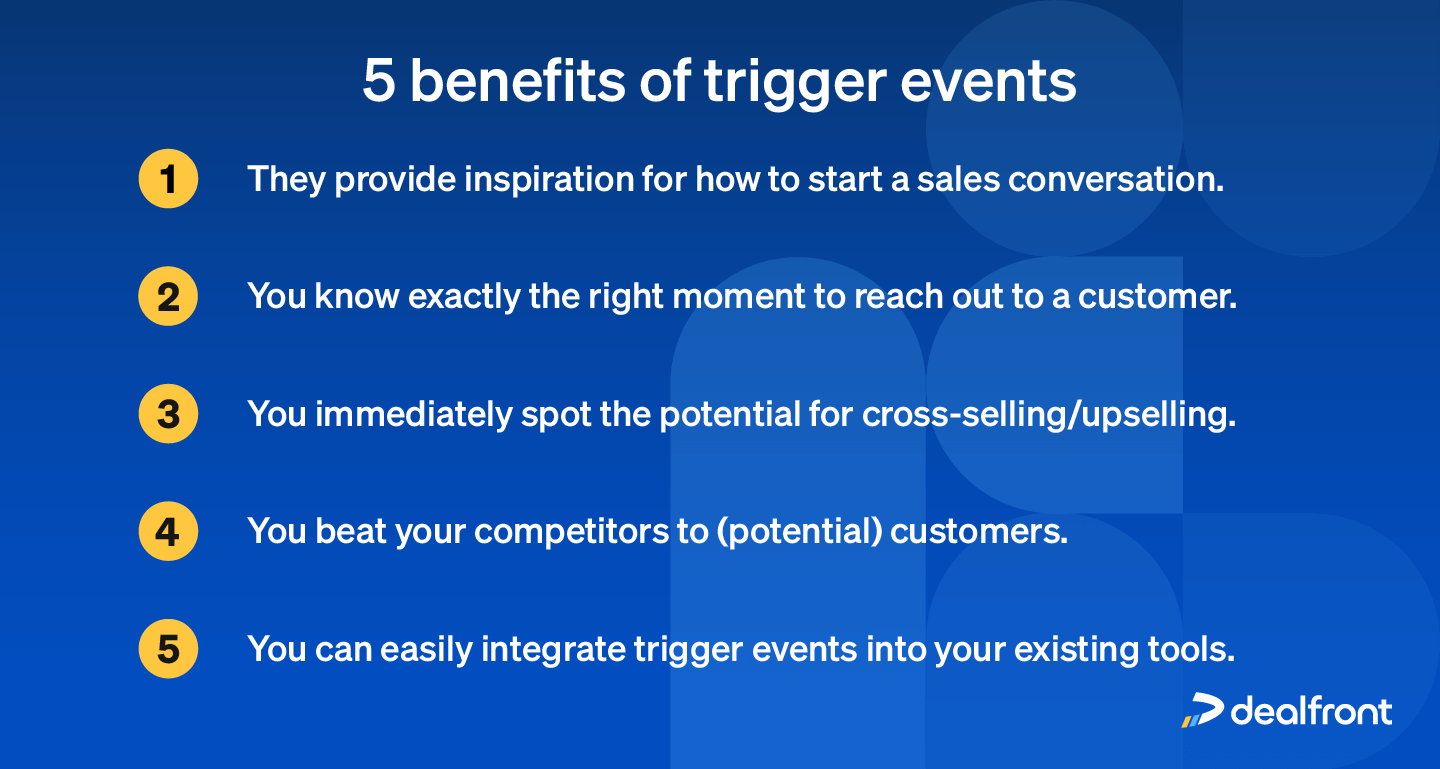
15 common trigger events and how to use them
So, how can you tell which sales trigger events are most important for your business? It depends largely on which type of products or services you offer. It also takes a little instinct for sales reps to recognize the right moment to approach a potential client.
It’s also important to remember that not all sales tools can identify trigger events. That means you may not be getting the full picture, depending on the tools and integrations you use.

To make sure you never miss out on a trigger event again, we’ve created this handy list of the top 15 trigger events that Dealfront can spot for you.
1. Incorporation
Each year, over 5 million new companies are founded in the US. Many companies have strong needs for products and services when they’re just starting out. This means they’re often very receptive to doing business and finding trustworthy suppliers. Wouldn’t it be handy if you knew, for example, when a new start-up was founded that might be a perfect match for your offering?
With Dealfront, you can! If you’re targeting start-ups, Dealfront can notify you whenever relevant companies in your market are founded. Our trigger events adhere to the highest standards of data security, such as the EU’s GDPR legislation.
2. Relocation
Companies relocate every day, for all different reasons. But when they do, it’s always a trigger event. It’s the perfect opportunity to learn about the company, why it’s moving and how you might be able to cater to its changing needs.
A company relocation is an especially interesting trigger event if you offer business-related products and services, such as IT support, facilities management or office supplies. But no matter what B2B product or service you offer, a customer’s relocation is always a good moment to check in and see if there’s anything you can offer.
3. New building
Similar to a relocation, a new building is a sign of changing times within a company – and it’s often a sign that the company is doing well. What better time than a moment like this to reach out and offer your products and services?
A new building is often also accompanied by new needs. Maybe the company’s workforce is expanding. They might need new IT services and support. Or perhaps they’re upgrading processes to scale up their business – all excellent reasons for you to take advantage of this trigger event.
4. New contact
Staffing changes within your target company can also be a powerful trigger event. Perhaps you didn’t have a very strong click with a contact person at the company. If that person leaves the company, now’s your chance to reach out to their successor and make a strong first impression.
As you know, successful sales often depend on the right personal connection. It’s always worth trying your luck when a new decision-maker comes on board. Maybe the chemistry will be better than with their predecessor.
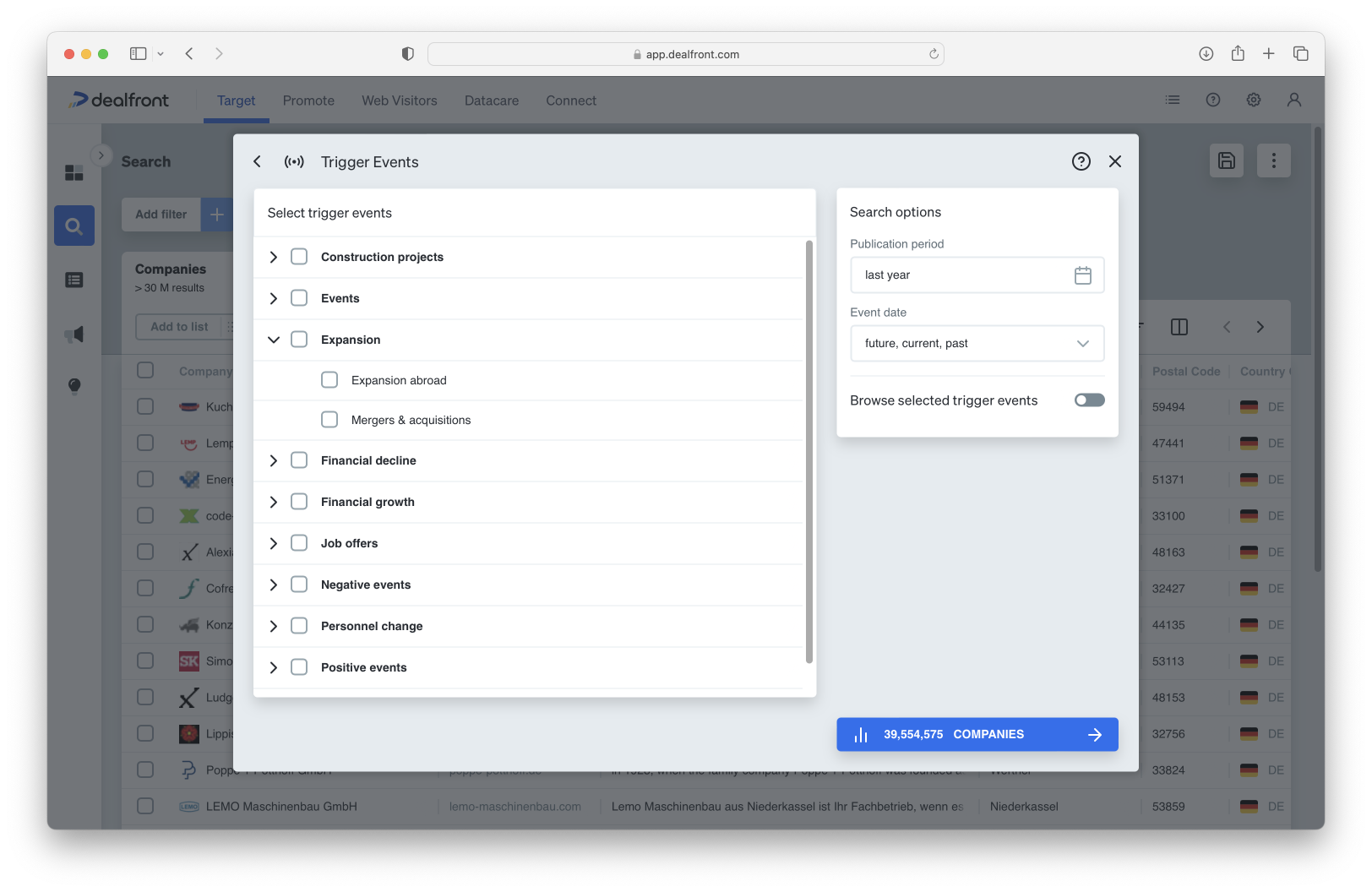
Example view of trigger events in Dealfront
5. Change in leadership
Depending on the size of your target company, you and your sales team may not even have direct contact with the C-level. But a shakeup in the boardroom always leads to fundamental leadership changes that impact the entire company. This can be the perfect moment to reach out with your B2B sales pitch!
New C-suite executives means new decision-makers, a new strategy and possibly new budgeting priorities. That’s why it’s always wise to check in with your contacts any time you learn of a change like this.
6. Expanding teams
Any time a company grows, it’s generally going to need more products and services. A sure sign of growth is an increase in personnel. This can also be a sign that the business is diversifying/expanding into new areas. It’s a classic trigger event that presents new opportunities for a savvy B2B sales rep.
When you spot a trigger event like this, research to learn what new skills new employees will bring with them or which areas they’ll be responsible for. Suppose the target company is expanding its marketing department and you happen to offer marketing automation software. Perfect match! Time to start cross-selling and upselling! Those new employees will probably need additional licenses, which gives you an excellent way to open the conversation.
7. Job vacancies
Job vacancies are another important trigger event that can tell you a lot about a company. If a company is suddenly hiring for employees (new hires) with certain skill sets, you can get an idea of which way their strategy is developing, and what they might need.
Of course, If you’re working for a recruitment firm, seeing a lot of vacancies is an opportunity to offer your services. But job vacancies can trigger any type of B2B sales: remember that any time a target company shows signs of growth, it’s a positive sign – and a great opportunity to make a sale.
8. Trade fairs
Trade fairs are designed to facilitate new deals and partnerships between companies. So, if one of your target companies is attending an upcoming trade show, you won’t want to miss it!
At B2B trade shows, you’ll have plenty of networking opportunities and you can even book meetings in advance with prospective clients. Or make a list of contacts you want to invite to the after party at your stand!
9. International expansion
International company expansion is another sign that a company is in good shape and probably in need of trusted suppliers in their new market. They may also be dealing with organizational and logistical challenges, which can be a golden opportunity if your company specializes in those kinds of B2B services.
Having trusted suppliers makes life easier for companies during their expansion. Pivotal moments like these are an ideal time to establish a relationship. With a little luck (and hard work on your part) it will grow into a lucrative, long-term business partnership.
Use testimonials from your existing customers to back up your sales pitch. The best way to convince a new customer is to show them what your satisfied customers say about your company.
10. Major new contract
Every company relies on new contracts and sales to continue growing. Whenever one of your target customers lands a major new contract, it’s a moment for them to celebrate – and a positive trigger event for you! That big new project they’ve got means they’ll also be needing more products and services from their suppliers.
This is especially a potentially lucrative event for you if you happen to offer services like IT support, consulting, project management, subcontracting or staffing, which your customer may need when working on their big new project. But no matter what type of B2B product or service you offer, a new contract for your target customer is always an opportunity to make a pitch.
11. Strong or weak financial performance
As a B2B sales person, you know that a company’s financial performance has a direct impact on its budget. If a company reports strong profits, you can usually expect to see it investing more in products and services to grow the business.
That’s why it’s a great idea to monitor your target customers’ financial performance. If you know the company is thriving, it may be easier to make a sale. But even if the company is in bad shape – or even going through bankruptcy proceedings – that’s important information for you to know as well. In that case, you might focus more efforts on that customer’s direct competitors who will be gaining in market share. Bottom line: it pays to keep your eyes open to any changes in your target customers’ financial state.
12. Strong quarter/weak quarter
Speaking of finances: suppose a company you’re targeting closes out a quarter with strong results. That’s usually a sign that they’ve got a budget surplus to spend on new products and services – a perfect trigger event for you to get in touch!
On the flip side, if a company is losing money or facing economic challenges - maybe even a crisis – resulting in a weak quarterly report, try to turn it into a positive. You could frame your pitch so that it shows how you want to help your customer get back on track. Again, it’s always wise to keep an eye on how things develop. Depending on what your company offers, you may be able to offer support in case your customer needs to downsize, relocate or seek consulting services.
13. Awards/recognition
When a company excels in its field or receives an award for one of its products, it's a great opportunity for you to reach out and congratulate them. After all, everyone loves recognition for a job well done. Why not send them a nice card in the mail? As long as your customer is opted in for marketing, direct mail marketing is allowed under the EU’s GDPR and US direct marketing regulations. But non-marketing messages can be sent without any problem.
In any case, a message of congratulations is probably one of the most positive conversation starters, especially in B2B cold outreach. So, be sure to take advantage of moments like this to stay on your customer’s radar. It’s also important to be the first to congratulate them. Don’t wait for your competitors to get ahead of you.
14. Competition
Speaking of competition, gaining information about your competitors or insights into your own market is invaluable!
Often, you can learn whether a potential customer is dissatisfied with their current provider through social media, review platforms like G2 or Capterra, or through conversations within your network. These are often strong indicators that it’s time to reach out to the customer and position your brand as the solution they’ve been waiting for.
Sales Intelligence tools like Dealfront let you easily find out which tools your target companies use. Dealfront extracts this information from company websites and presents you with a structured overview. For instance, if you offer a product for website building or data management, you can see right away which companies are using your competitors' solutions. That means you can tailor your communications with those companies to show them how you outperform their current supplier.
15. Mergers and acquisitions
Mergers and acquisitions occur all the time in the business world. When a company changes ownership or organizational structure, it often also changes suppliers. Usually, a merger or acquisition is a moment for companies to seek new solutions and get rid of old tools and processes that haven’t worked well for them.
These trigger events also offer strong sales opportunities for you! A newly acquired company may receive an injection of capital from its new owner, which means new funding is available for spending. New leadership and contacts within the company may also present new possibilities for you to establish a lucrative partnership.
How to recognize trigger events early on
It’s easy to see how trigger events can help you increase your B2B sales. But how do you actually find out when a trigger event has occurred?
The events we’ve described above are not secrets that are only available to people with insider knowledge. In fact, most companies openly communicate about trigger events – especially when it’s good news – because they can help enhance the brand’s public image.

That means you can find lots of information about trigger events in communications from the companies themselves: on their websites, in press releases and on social media. There are also many public directories and commercial registries where you can find legal information, such as articles of incorporation, financial reporting or details about mergers, acquisitions or relocations. In Europe and the US, it’s usually mandatory for companies to report on major events such as a merger, acquisition or incorporation.
So, there’s no shortage of information out there. The real challenge for B2B salespeople is to filter out the right information and spot a trigger event before your competitors beat you to it. In the past, this would have been a time-consuming task, making it almost not even worth the effort.
Fortunately, now there’s an easier way: Sales Intelligence software delivers trigger events right to your email inbox
Sales triggers can be found in company reports, company websites, independent reviews and social media channels. But also legal documentation, terms and conditions, recruitment websites, company directories and registers. In short, so many places, and too many to work with manually. All the sales trigger information mentioned in this article so far is publically available. Your time should be spent interacting with prospects based on the information at your fingertips, not finding the information.
So how can you quickly get alerted to this highly valuable data, without spending days, or realistically, weeks and months on end looking for it?
This is where a software solution comes in, Sales Intelligence tools save you time and money by not only delivering trigger events but also high-quality B2B leads and valuable insights.
The Sales Intelligence solution from Dealfront does just this! You can use more than 100 unique filters, including sales triggers, to find accounts that show true opportunity. Combining the right trigger events with filters such as industry, company size, location, etc, to match your ideal customer profile (ICP), will really refine your list down. The end result is a GDPR compliant list of companies and decision makers ideally suited to hearing from you at this point in time.
With Dealfront, you can get sales trigger alerts sent directly to your inbox as an email. Once the alerts are set up, you never have to think about sales triggers again, all you have to do is integrate the information into your existing outreach process and start some conversations!
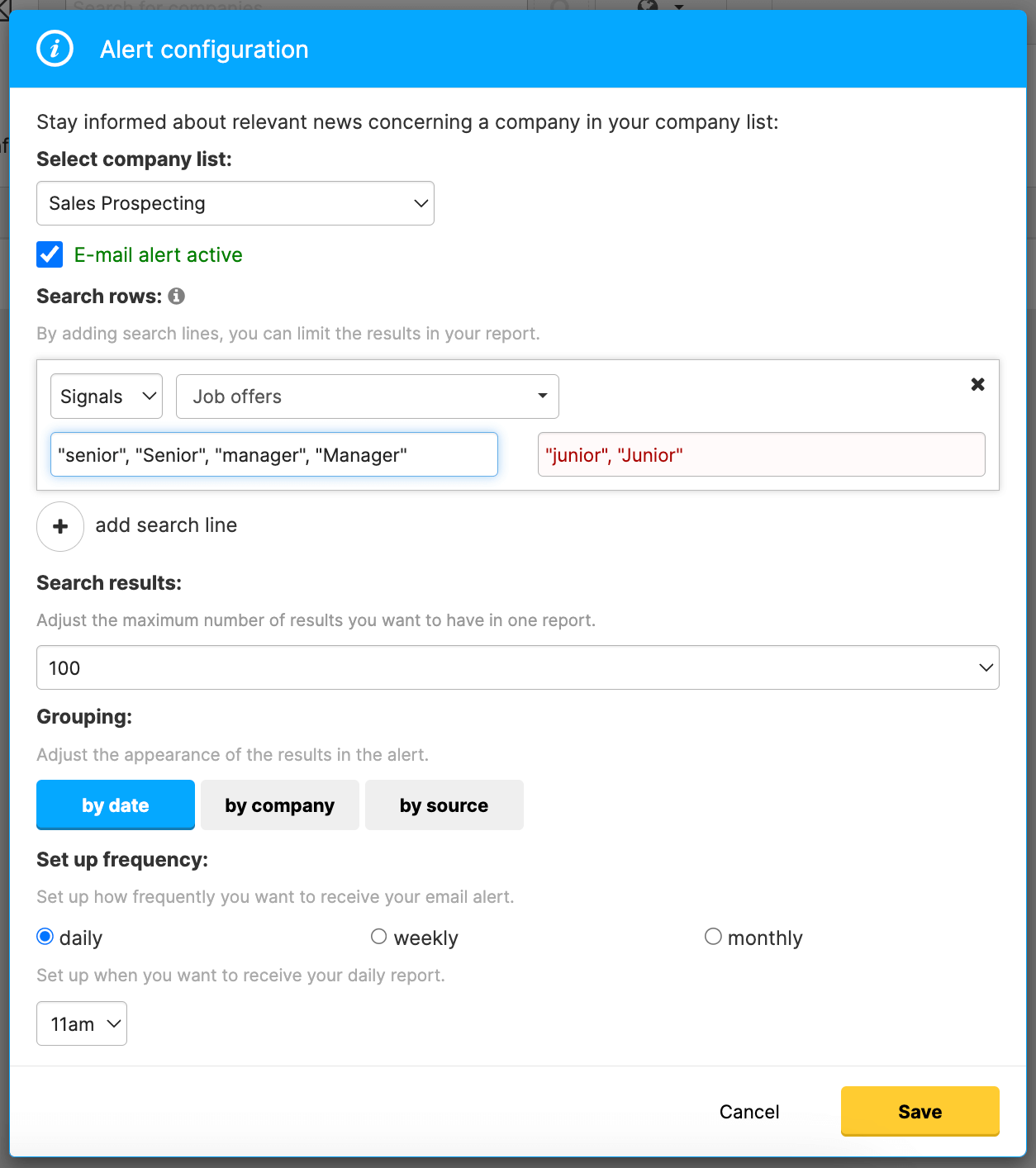
Setting Up B2B Sales Triggers
There are other ways to identify trigger events as early as possible other than Dealfront of course:
LinkedIn: Following potential customers from your target group, existing customers or individuals on social media often reveals sales opportunities and promotes engagement. Having a strong presence on these platforms pays off!
Search engines e.g. Google: Doing your own research online is always worthwhile to find out important, real-time information and industry news affecting your target customers. You can use Google alerts and other notification services to keep informed of possible trigger events.
Newsletters & reports: Sign up for (potential) customers’ newsletters and public reports to automatically stay up-to-date.
If you want to see whether your acquisition efforts using trigger events are paying off, check whether the companies you’re targeting are visiting your website. Tools like Leadfeeder from Dealfront show you which companies are visiting your website and which content and pages they’re looking at. That’s a goldmine of information for sales teams!
Boost your B2B sales with trigger events
By monitoring and acting on trigger events, you can make a big impact on your B2B sales performance. Reaching out to potential customers at the right time – with the right conversation starters and a tailored offer – is a far more effective approach than traditional cold calling. It’s even more useful if you’re using an accounts-based approach to sales and marketing.
The good news is: there’s no need to spend time manually searching for trigger events. A modern Sales Intelligence tool like Dealfront can take care of that for you. We take care of the monitoring and research, so you can devote your time to doing what you do best – crafting a compelling B2B sales pitch and building strong contacts with your customer base.


